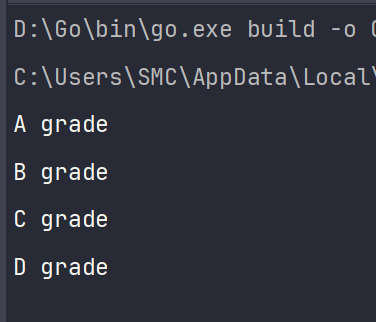Go 条件判断
Go 语言的条件判断主要使用 if、else、else if 和 switch,虽然与其他主流编程语言类似,但也有一些独特的特点。我在这里分享一下对这些条件判断的理解和使用方法。
if 语句
在 Go 语言中,if 语句可以包含一个可选的初始化语句,该语句会在条件判断之前执行。此外,if 条件表达式不需要使用括号包围,但代码块必须使用花括号 {}。
func checkNumber(num int) {
if remainder := num % 2; remainder == 0 {
fmt.Println(num, "是偶数")
} else {
fmt.Println(num, "是奇数")
}
}
在上述代码中,我使用了一个初始化语句 remainder := num % 2,remainder 的作用域仅限于 if-else 代码块内部。
else 和 else if 语句
else 和 else if 的使用方式与 if 类似,需要注意的是,else 或 else if 必须紧跟在 if 语句的右花括号 } 之后,不能换行。else if 提供了额外的条件判断,避免了多层嵌套的 if-else 结构。
func checkScore(score int) {
if score >= 90 {
fmt.Println("A级")
} else if score >= 80 {
fmt.Println("B级")
} else if score >= 70 {
fmt.Println("C级")
} else {
fmt.Println("D级")
}
}
在这个例子中,我根据分数输出对应的等级,else if 语句使得代码逻辑清晰明了。
switch 语句
Go 语言的 switch 语句有一些不同于其他语言的特点。首先,它可以不使用表达式,在这种情况下,switch 会匹配 true。其次,switch 语句可以包含初始化语句,就像 if 语句一样。此外,case 语句可以包含多个条件,使用逗号 , 分隔。
func checkNumber(num int) {
switch remainder := num % 2; remainder {
case 0:
fmt.Println(num, "是偶数")
default:
fmt.Println(num, "是奇数")
}
}
在上面的 switch 示例中,我使用了初始化语句 remainder := num % 2,然后根据 remainder 的值进行判断。
func checkScore(score int) {
switch {
case score >= 90:
fmt.Println("A级")
case score >= 80:
fmt.Println("B级")
case score >= 70:
fmt.Println("C级")
default:
fmt.Println("D级")
}
}
在这个示例中,我的 switch 后没有跟任何表达式,case 条件会从上到下依次判断,匹配到第一个满足条件的分支后执行。
fallthrough 语句
Go 语言的 switch 语句在每个 case 后默认会自动结束,无需显式地写出 break。如果希望继续执行下一个 case,需要使用 fallthrough 语句。
func checkScore(score int) {
switch {
case score >= 90:
fmt.Println("A级")
fallthrough
case score >= 80:
fmt.Println("B级")
fallthrough
case score >= 70:
fmt.Println("C级")
fallthrough
default:
fmt.Println("D级")
}
}

在这个例子中,使用了 fallthrough,所以当分数大于等于 90 时,会连续输出所有等级。
多重匹配
Go 语言的 switch 语句可以在 case 中匹配多个条件,条件之间使用逗号 , 分隔。
func main() {
checkScore(90)
checkScore(80)
checkScore(70)
}
func checkScore(score int) {
switch {
case score >= 90, score >= 80, score >= 70:
fmt.Println("A级")
default:
fmt.Println("D级")
}
}
在这个示例中,case 条件包含了多个表达式,任何一个表达式为 true,都会执行对应的代码块。